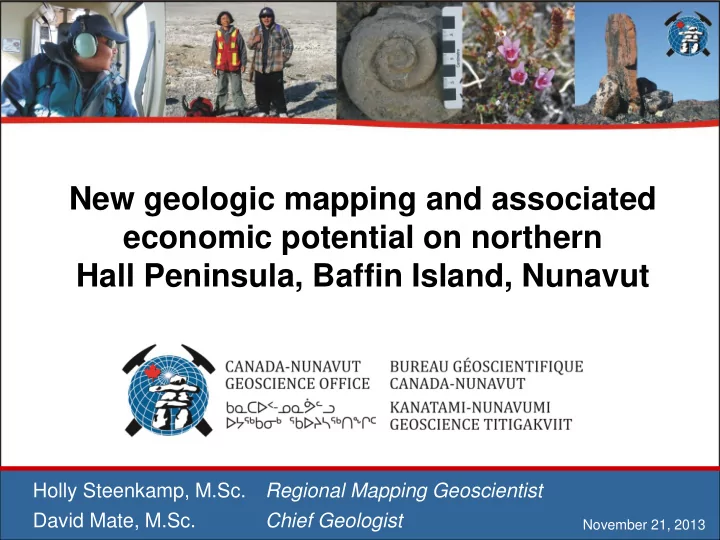

+ New geologic mapping and associated economic potential on northern Hall Peninsula, Baffin Island, Nunavut Holly Steenkamp, M.Sc. Regional Mapping Geoscientist David Mate, M.Sc. Chief Geologist November 21, 2013
Hall Peninsula Integrated Geoscience Project Gather geoscience information to aid in accurately interpreting the tectonostratigraphic and metamorphic evolution of Hall Peninsula, and evaluate the potential for economic resources in this area. • Collaborative effort • 7 Canadian universities (2 PhD, 5 MSc, 1 BSc) • GSC - Ottawa • AANDC • GN • Nunavut Arctic College • Field mapping in 2012 and 2013 • Bedrock at 1:250,000 • Surficial sediment at 1:100,000 • Detailed thematic studies
Hall Peninsula Integrated Geoscience Project ᐱᓕᕆᕝᕕᐅᔪᑦ Project 2013 Field Campaign Areas: • Northern Hall Peninsula • 10 days out of Iqaluit • 38 days out of Sunrise Camp (rented from Peregrine Diamonds) • Traverses and targeted helicopter stops
Bedrock Field Observations Eastern Rock Units: • Archean basement orthogneiss - tonalite to monzogranite Steenkamp and St-Onge (in press)
Bedrock Field Observations Eastern Rock Units: • Archean basement orthogneiss - tonalite to monzogranite • Overlain by supracrustal strata - quartzite, psammite, pelite, ironstone, amphibolite, calc- silicate units - record amphibolite-facies metamorphism Steenkamp and St-Onge (in press)
Bedrock Field Observations Western Rock Units: • Supracrustal strata - psammite to pelite - record granulite-facies metamorphism Steenkamp and St-Onge (in press)
Bedrock Field Observations Western Rock Units: • Supracrustal strata - psammite to pelite - record granulite-facies metamorphism • Opx ± Cpx ± Mag felsic intrusives - tonalite to quartz diorite - ‘ charnockite ’ panels Steenkamp and St-Onge (in press)
Bedrock Field Observations Western Rock Units: • Supracrustal strata - psammite to pelite - record granulite-facies metamorphism • Opx ± Cpx ± Mag felsic intrusives - tonalite to quartz diorite - ‘ charnockite ’ panels • Grt ± bt leucogranite - Likely generated by muscovite and/or biotite dehydration melting in supracrustal units Steenkamp and St-Onge (in press)
Bedrock Field Observations Metamorphism: • Increasing grade from E to W Deformation: • 3 major phases documented Steenkamp and St-Onge (in press)
Bedrock Field Observations Metamorphism: D 1 • Increasing grade from E to W Deformation: • 3 major phases documented D 2 Steenkamp and St-Onge (in press)
Bedrock Field Observations Metamorphism: D 3 • Increasing grade from E to W Deformation: • 3 major phases documented Steenkamp and St-Onge (in press)
Bedrock Field Interpretations 1. Paleoproterozoic sedimentary strata suggest gradational change from shallow marine to shelf or slope-rise depositional setting within proximity to a local rifting environment. 2. Increasing metamorphic grade from E to W, and fold and thrust geometry likely represent a transition from an orogenic foreland to hinterland, related to the terminal collision of the Trans-Hudson Orogen. Steenkamp and St-Onge (in press)
Economically Interesting Finds • Two layered mafic- ultramafic intrusions • 25 ultramafic intrusions with post-emplacement hydrothermal alteration • 9 silicified gossans • Calc-silicate containing marble and semi-precious fluorapatite • Granitic pegmatites Steenkamp and St-Onge (in press); Steenkamp et al. (in press)
Layered Mafic-Ultramafic Intrusions – Ni-Cu-PGE Northern LM-UI Southwestern LM-UI Steenkamp et al. (in press)
Northern LM-UI • Three segments over ~7 km distance • Sills emplaced in garnet-biotite- psammite • Rip-up clasts embedded in base of intrusion • Magmatic internal layering from clinopyroxenite to layered peridotite to gabbro • Tectonic context and mineralogy comparable to the upper Raglan-type deposits in the Cape Smith Belt in northern Quebec Steenkamp et al. (in press)
Northern LM-UI • Three segments over ~7 km distance • Sills emplaced in garnet-biotite- psammite • Rip-up clasts embedded in base of intrusion • Magmatic internal layering from clinopyroxenite to layered peridotite to gabbro • Tectonic context and mineralogy comparable to the upper Raglan-type deposits in the Cape Smith Belt in northern Quebec
Northern LM-UI • Three segments over ~7 km distance • Sills emplaced in garnet-biotite- psammite • Rip-up clasts embedded in base of intrusion • Magmatic internal layering from clinopyroxenite to layered peridotite to gabbro • Tectonic context and mineralogy comparable to the upper Raglan-type deposits in the Cape Smith Belt in northern Quebec
Hydrothermally Altered Ultramafics – Carving Stone • Basement-hosted Basement-hosted • Isolated plugs or boudinaged sills • Alteration pervasive at contact • Supracrustal-hosted • Laterally continuous sills Supracrustal-hosted • Penetrative alteration throughout • Primary ultramafic mineralogy replaced by tremolite, actinolite, phlogopite, serpentine, and minor talc • Potential source of carving stone
Silicified Gossans – Sulphide Mineralization • Hosted in supracrustal strata • Locally associated with graphite schist • Pyrrhotite- and pyrite- bearing
Calc-silicate – Marble Carving Stone & Fluorapatite • Typically found near the base of the supracrustal stratigraphy • Contains minor layers and lenses of marble • Possible source of carving stone • Blue fluorapatite documented at one locality • Possible source of semi- precious gemstone
Granitic Pegmatites – Rare Earth Elements • Relatively late, cross-cut through basement and supracrustal strata • Concentrated in the eastern portion of field area • Contain biotite, muscovite, and/or tourmaline • Potential source of Rare Earth elements.
Continued Research & Future Work • University collaborators continue to collect analytical data: – Geochronology: deposition , intrusion, and metamorphism – Geochemistry of mafic and ultramafic units – Isotope geochemistry to characterize the basement orthogneiss components – Pressure and temperature estimates of metamorphism – Regional uplift • CNGO 2013 Summary of Activities (January 2014) – Articles and raw datasets will be available for download from www.cngo.ca • 2014/2015: – Final Hall Peninsula field season - targeted mapping and thematic studies – Rare Earth element potential of granitic pegmatites – Northern Hall Peninsula geological map (April 2014) – Hall Peninsula surficial geology map (2014) – Hall Peninsula geological compilation map (Early 2015)
Thank you! Hall Peninsula Geoscience Crew University of Alberta Dalhousie University Peregrine Diamonds Ltd. Université Laval De Beers Canada Exploration University of Manitoba Universal Helicopters University of Ottawa University of Saskatchewan University of Waterloo
Recommend
More recommend